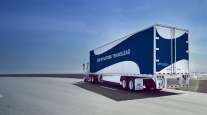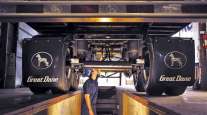Senior Reporter
Trailer Orders Rise 19% in April to 20,200; Positive Trend Continues for 7th Month

This story appears in the May 22 print edition of Transport Topics.
U.S. trailer orders in April rose 19% in what analysts said was an extended growth cycle that shows no signs of reversing.
April orders were 20,200, according to ACT Research Co.’s preliminary estimate. That compares with 16,911 in the same year-earlier period.
“It’s a very solid number. The big thing is we are still running good positives on a year-over-year basis,” Frank Maly, ACT’s director of commercial vehicle transportation analysis and research, told Transport Topics.
It was the seventh consecutive month with orders exceeding 20,000 and the fifth consecutive month of year-over-year gains, the company said.
Both dry vans and platform trailers had the best year-over-year comparisons in April, but refrigerated trailers were down about 20% year-to-date.
“Where we are seeing cancellations, they seem to be particular deals. But volumewise, we are not really seeing anything that is a major concern right now,” he added.
Research company FTR pegged its net total at 20,000 units, as fleets continue to place orders for second-half delivery, and dealer orders also are brisk, according to FTR.
“The trailer market held onto the strong production gains of March, which is a great sign for future sales,” said Don Ake, FTR vice president of commercial vehicles.
Likewise, trailer makers remained upbeat.
“It goes back to the lack of orders in the fall that are being placed January through April,” said David Gilliland, vice president of national accounts at Great Dane Trailers. “Dry vans are much better than ACT and FTR thought in the fall. Also, older inventory is being worked through the original equipment manufacturers and dealers, allowing new orders to be placed.”
Demand appears to be good in a very normal market, said David Giesen, vice president of sales for Stoughton Trailers.
“Fleets continue to replace for newer equipment. There could be some pre-ordering to get ahead of the greenhouse gas Phase 2 rules that are still set to come into play for January 2018, though I am not hearing this as an expressed reason for orders,” Giesen said.
Phase 2 of the greenhouse gas rule — developed by the U.S. Environmental Protection Agency and the Department of Transportation’s National Highway Traffic Safety Administration — encourages new and advanced cost-effective technologies that promote cleaner, more fuel- efficient trucks. The vehicle and engine performance standards would cover model years 2018-2027 for certain trailers.
The trailer industry is in an extended cycle, Rhem Wood, an analyst with Seaport Global Securities, wrote in a May note to investors. “That said, we are approaching the end of the busy season for trailer orders, which are typically stronger in Q4 and Q1, and orders typically fall off in April, May and June, while July tends to be the lowest month of the year,” Wood wrote.
April orders were fairly in line with his expectations, Stifel, Nicolaus & Co. analyst Michael Baudendistel noted.
He increased his 2017 industry production estimate to 275,000 units from 265,000, he wrote to investors, “to reflect our expectation that orders will remain above prior-year levels in the coming months.”
Charles Willmott, chief sales officer at Strick Group, said quote requests and the flow of orders remain solid but slower than in the “frenetic” first quarter, and Strick has a full production schedule for the remainder of 2017.
However, he mentioned hearing anecdotal reports that suggested other trailer makers have idle capacity in the third and fourth quarters, especially for composite-plate vans.
“This is not surprising, given the manufacturing capacity expansion our industry has seen in the last 18 months,” he said. “We believe that the industry capacity to build composite plate dry vans now exceeds recent historic high demand by about 10%.”
A “fierce” price competition between the largest producers of the composite plate trailers, is possible. “At least until or unless demand increases unexpectedly or a consolidating shakeout takes place on the supply side,” Willmott said.
Glenn Harney, chief sales officer at Hyundai Translead, agreed the market is benefiting from a variety of factors.
“I can’t say any one thing is driving it. Some replacement of very old trailers is still a factor,” Harney said. “Dealers came into 2017 with more inventory than usual and have now worked off most of it and are ordering. Fleets are still buying.”




